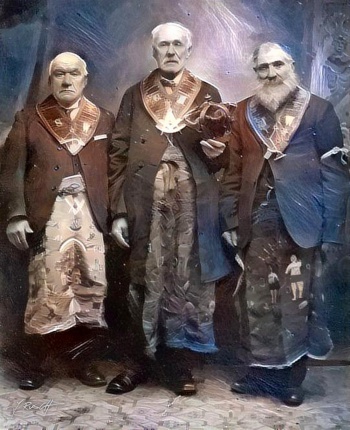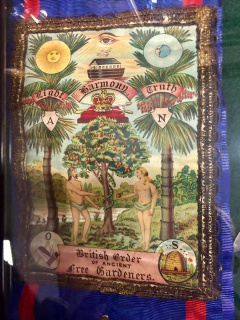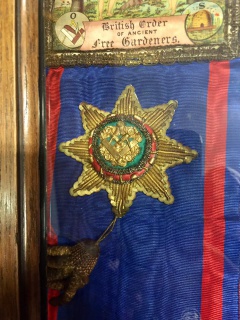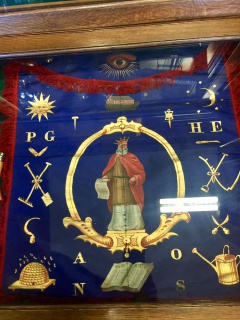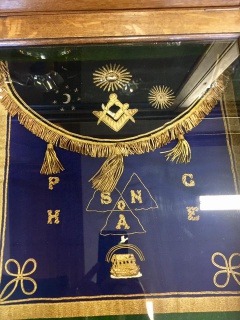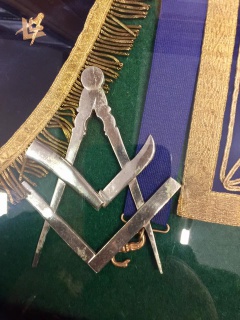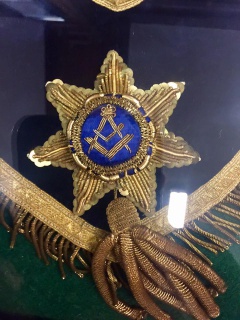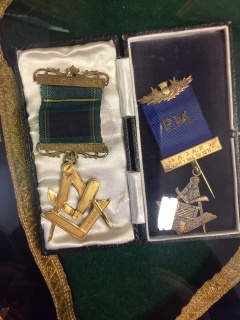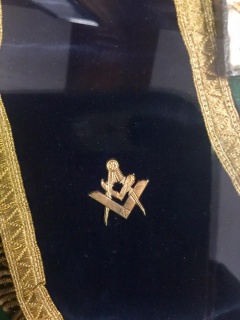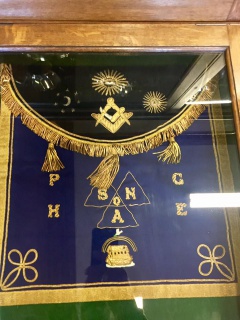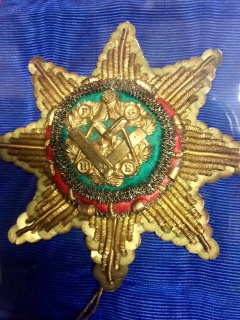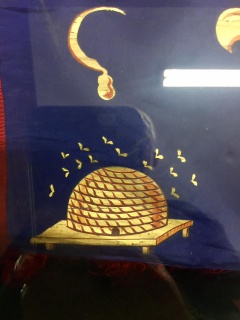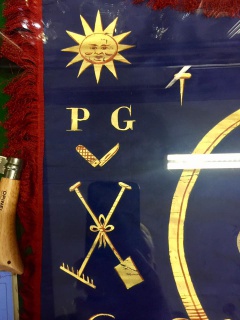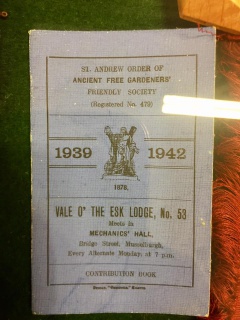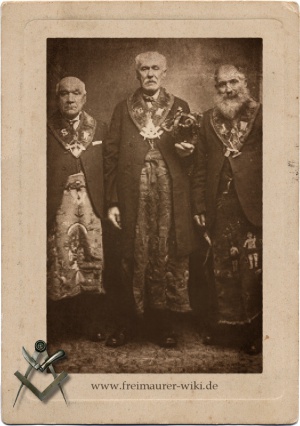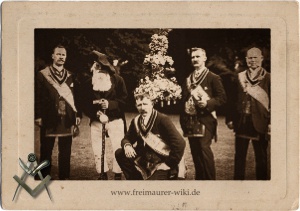En: Free Gardeners: Unterschied zwischen den Versionen
K |
|||
| (14 dazwischenliegende Versionen von 5 Benutzern werden nicht angezeigt) | |||
| Zeile 1: | Zeile 1: | ||
| + | [[Datei:Freegardeners 3opt.jpg|thumb|350px]] | ||
== Order of Free Gardeners == | == Order of Free Gardeners == | ||
| − | From Wikipedia, the free encyclopedia | + | [http://en.wikipedia.org/wiki/Order_of_Free_Gardeners From Wikipedia, the free encyclopedia] |
| − | |||
The Order of Free Gardeners is a fraternal society that was founded in Scotland in the middle of the 17th Century and later spread to England and Ireland. Like numerous other friendly societies of the time, its principal aim was the sharing of knowledge—secrets—linked to the profession and mutual aid. In the 19th Century, its activities of mutual insurance became predominant. By the end of the 20th Century it had become almost entirely extinct. | The Order of Free Gardeners is a fraternal society that was founded in Scotland in the middle of the 17th Century and later spread to England and Ireland. Like numerous other friendly societies of the time, its principal aim was the sharing of knowledge—secrets—linked to the profession and mutual aid. In the 19th Century, its activities of mutual insurance became predominant. By the end of the 20th Century it had become almost entirely extinct. | ||
| Zeile 12: | Zeile 12: | ||
The most ancient evidence of the order is a record of the minutes of the Haddington lodge, opened 16 August 1676, which begins with a compilation of fifteen rules called Interjunctions for ye Fraternity of Gardiners of East Lothian. | The most ancient evidence of the order is a record of the minutes of the Haddington lodge, opened 16 August 1676, which begins with a compilation of fifteen rules called Interjunctions for ye Fraternity of Gardiners of East Lothian. | ||
| − | |||
Edzell Castle's walled garden, Scotland, dates back to 1604. | Edzell Castle's walled garden, Scotland, dates back to 1604. | ||
| Zeile 28: | Zeile 27: | ||
Encouraged by this success, competing horticultural societies appeared during the 19th Century. Unlike the Free Gardeners, they did not have a charitable role, mutual help, or rituals, and they would accept anybody, male or female, who paid their dues. | Encouraged by this success, competing horticultural societies appeared during the 19th Century. Unlike the Free Gardeners, they did not have a charitable role, mutual help, or rituals, and they would accept anybody, male or female, who paid their dues. | ||
| − | In the 20th Century, the two World Wars called up most of the members. The economic crisis of 1929 weakened their charitable capacities.[3] The social protection laws weakened the attraction of mutual aid, before the National Insurance Act 1946 removed their entire purpose. Even before the Second World War, the number of deaths exceeded the number of admissions to the lodges. In 1939, the minutes of the Haddington lodge were interrupted until 1952, when its eight last members attempted in vain to relaunch it. Despite the recruitment of new members, the Haddington fraternity pronounced its dissolution on 22 February 1953. | + | In the 20th Century, the two World Wars called up most of the members. The economic crisis of 1929 weakened their charitable capacities.[3] The social protection laws weakened the attraction of mutual aid, before the National Insurance Act 1946 removed their entire purpose. Even before the Second World War, the number of deaths exceeded the number of admissions to the lodges. In 1939, the minutes of the Haddington lodge were interrupted until 1952, when its eight last members attempted in vain to relaunch it. Despite the recruitment of new members, the Haddington fraternity pronounced its dissolution on 22 February 1953. |
| − | These disappearances were part of a wider social change. In 1950 there were around 30,000 Friendly Societies in the UK, while in 2000 there were fewer than 150. | + | |
| + | The Dunfermline lodge lasted until the middle of the 1980s. | ||
| + | These disappearances were part of a wider social change. In 1950 there were around 30,000 Friendly Societies in the UK, while in 2000 there were fewer than 150. | ||
| + | In 2000, the research of R. Cooper counted no more than a single lodge (in Bristol) for Great Britain, but mentioned the survival of the Order of Free Gardeners in the Antilles (Caribbean British Order of Free Gardners) and in Australia. | ||
| + | In 2002, a conservation society was created in Scotland with aims of research and conservation of the traditions of this Order and some lodges were revived on this occasion. | ||
As of 2013, The Grand United Order of Free Gardeners still operates in Victoria, Australia from the East Kew Masonic Centre. It meets monthly under the auspices of the Victorian Grand Lodge #1, and is the only known lodge operating in the southern hemisphere. | As of 2013, The Grand United Order of Free Gardeners still operates in Victoria, Australia from the East Kew Masonic Centre. It meets monthly under the auspices of the Victorian Grand Lodge #1, and is the only known lodge operating in the southern hemisphere. | ||
| − | == Ritual == | + | === Ritual === |
| − | |||
Fraternity documents from the end of the 17th century reveal no trace of secret knowledge or rituals. However, the interest rapidly shown by the members of the aristocracy suggests this association did not exclusively deal with mutual assurance. | Fraternity documents from the end of the 17th century reveal no trace of secret knowledge or rituals. However, the interest rapidly shown by the members of the aristocracy suggests this association did not exclusively deal with mutual assurance. | ||
| Zeile 40: | Zeile 42: | ||
The oldest known mention of the existence of an initiation secret in this order appears on 28 January 1726, when the fraternity studied an internal complaint that accused one of its members of defaming certain of its officers in saying they could not correctly give its words and signs. In 1772, other documents established that the fraternity of the Free Gardeners had 'Words' and 'Secrets'. An 1848 document mentions a teaching, in the form of 'Signs, Secrets and Grips'. Historians have at their disposal complete rituals of the Apprentice, Companion and Master dating from 1930. Minutes of the lodges show that the ritual of the order progressively developed, from a fairly basic ceremony of transmission of the 'Word' at its very beginnings, to a system of three grades similar to that of Freemasonry at the end of the 19th Century. | The oldest known mention of the existence of an initiation secret in this order appears on 28 January 1726, when the fraternity studied an internal complaint that accused one of its members of defaming certain of its officers in saying they could not correctly give its words and signs. In 1772, other documents established that the fraternity of the Free Gardeners had 'Words' and 'Secrets'. An 1848 document mentions a teaching, in the form of 'Signs, Secrets and Grips'. Historians have at their disposal complete rituals of the Apprentice, Companion and Master dating from 1930. Minutes of the lodges show that the ritual of the order progressively developed, from a fairly basic ceremony of transmission of the 'Word' at its very beginnings, to a system of three grades similar to that of Freemasonry at the end of the 19th Century. | ||
| − | + | === Garden of Eden === | |
| − | |||
| − | == Garden of Eden == | ||
| − | |||
A conference of 1873 indicates that Free Gardening used the cultivation of soil as the symbol of the nurturing of the spirit in intelligence and virtue and made reference to the Garden of Eden. | A conference of 1873 indicates that Free Gardening used the cultivation of soil as the symbol of the nurturing of the spirit in intelligence and virtue and made reference to the Garden of Eden. | ||
| Zeile 63: | Zeile 62: | ||
On numerous objects of the order dating from the very beginning of the 20th Century, one finds an emblem composed of a square, a compass and a grafting knife. As there is not a trace of this emblem in the earlier documents, it is probable that it had also been inspired lately by that of Freemasonry. | On numerous objects of the order dating from the very beginning of the 20th Century, one finds an emblem composed of a square, a compass and a grafting knife. As there is not a trace of this emblem in the earlier documents, it is probable that it had also been inspired lately by that of Freemasonry. | ||
| − | + | === The first members === | |
| − | |||
| − | == The first members == | ||
| − | |||
There is little information on the professions of the members before the end of the 17th Century. During this period the Haddington lodge included merchants, tailors and clerks as well as gardeners. All the members of the lodge were originally from the county. On the other hand, the lodge at Dunfermline, former capital of Scotland, prided itself on counting among its members 'numerous renowned persons of Edinburgh, as well as East Lothian including the Marquess of Tweeddale, the count of Haddington (Earl of Haddington), Lord William Hay etc.'. | There is little information on the professions of the members before the end of the 17th Century. During this period the Haddington lodge included merchants, tailors and clerks as well as gardeners. All the members of the lodge were originally from the county. On the other hand, the lodge at Dunfermline, former capital of Scotland, prided itself on counting among its members 'numerous renowned persons of Edinburgh, as well as East Lothian including the Marquess of Tweeddale, the count of Haddington (Earl of Haddington), Lord William Hay etc.'. | ||
| Zeile 74: | Zeile 70: | ||
Religiously, all the members of this time were Protestants and belonged to the Church of Scotland. Politically, on the other hand, there were all types. | Religiously, all the members of this time were Protestants and belonged to the Church of Scotland. Politically, on the other hand, there were all types. | ||
| − | + | === Comparisons with Freemasonry === | |
| − | == Comparisons with Freemasonry == | ||
| − | |||
In the 1720s, Scotland had a profusion of societies, fraternities, and clubs. Freemasonry and the Order of Free Gardeners are merely those that spread the furthest and lasted the longest. | In the 1720s, Scotland had a profusion of societies, fraternities, and clubs. Freemasonry and the Order of Free Gardeners are merely those that spread the furthest and lasted the longest. | ||
| Zeile 85: | Zeile 79: | ||
Freemasonry expanded rapidly in England and, after creation of the Grand Lodge in London in 1717, across the entire world. On the other hand, the Order of Free Gardeners remained principally Scottish. In both cases, the Scottish lodges seemed to have difficulties grouping together into larger structures called Grand Lodges. In the case of the Order of Free Gardeners, the first Grand Lodge only formed in 1849, and 15 lodges remained independent until the disappearance of the order. In both cases, it is in particular the lodges founded before their Grand Lodge that remain the most reluctant to renounce their independence. | Freemasonry expanded rapidly in England and, after creation of the Grand Lodge in London in 1717, across the entire world. On the other hand, the Order of Free Gardeners remained principally Scottish. In both cases, the Scottish lodges seemed to have difficulties grouping together into larger structures called Grand Lodges. In the case of the Order of Free Gardeners, the first Grand Lodge only formed in 1849, and 15 lodges remained independent until the disappearance of the order. In both cases, it is in particular the lodges founded before their Grand Lodge that remain the most reluctant to renounce their independence. | ||
| + | |||
| + | === Miscellaneous === | ||
| + | |||
| + | Ancient Free Gardeners, an indie-rock band in Melbourne, Australia, takes its name from the Free Gardeners, though the group has no association. The inspiration came from a visit to the Melbourne branch of the Free Gardeners, situated in Elizabeth Street, one block north of the Victoria Market. Whilst the Free Gardeners no longer meet at that location, the building still bears it's logo and inscription. | ||
| + | |||
| + | ---- | ||
== Free Gardeners == | == Free Gardeners == | ||
| − | The Free Gardeners of Edinburgh, the Lothians and Fife | + | Source: The Free Gardeners of Edinburgh, the Lothians and Fife |
A Self-help Edinburgh Lothians Fife (SHELF) Resource prepared for Resources for Learning in Scotland (RLS). | A Self-help Edinburgh Lothians Fife (SHELF) Resource prepared for Resources for Learning in Scotland (RLS). | ||
| Zeile 102: | Zeile 102: | ||
---- | ---- | ||
| − | == Introduction == | + | === Introduction === |
| − | |||
Free Gardeners of the Lothians and Fife | Free Gardeners of the Lothians and Fife | ||
Gardeners' societies appeared in Scotland during the seventeenth century. Working gardeners started societies to promote and regulate their profession and to support themselves in time of need. As time passed the main aim became the members' benefits - they were friendly societies. | Gardeners' societies appeared in Scotland during the seventeenth century. Working gardeners started societies to promote and regulate their profession and to support themselves in time of need. As time passed the main aim became the members' benefits - they were friendly societies. | ||
| − | |||
| − | |||
Non-gardeners could join most lodges. They were called 'free gardeners' and soon they out-numbered working gardeners. All through the 19th century free gardeners continued to found lodges despite the attractions of the many other friendly societies, such as the Foresters, Buffaloes or Oddfellows. Free gardeners made up their own rituals and practices, which helped unite the brethren of each lodge. | Non-gardeners could join most lodges. They were called 'free gardeners' and soon they out-numbered working gardeners. All through the 19th century free gardeners continued to found lodges despite the attractions of the many other friendly societies, such as the Foresters, Buffaloes or Oddfellows. Free gardeners made up their own rituals and practices, which helped unite the brethren of each lodge. | ||
Some of the societies joined together in 'Orders' led by a 'Grand Lodge'. There were several orders based in Edinburgh, Glasgow and England. Some of the older lodges stayed independent. At their height in the Lothians there were over 10,000 free gardeners organised in upwards of 50 lodges. Juvenile and even women-only branches opened at the end of the 19th century. | Some of the societies joined together in 'Orders' led by a 'Grand Lodge'. There were several orders based in Edinburgh, Glasgow and England. Some of the older lodges stayed independent. At their height in the Lothians there were over 10,000 free gardeners organised in upwards of 50 lodges. Juvenile and even women-only branches opened at the end of the 19th century. | ||
| − | |||
The free gardeners are now part of history. Some of the societies are known only by name. Many different collections hold a few surviving documents or pieces of regalia. Luckily, the archives of the Dunfermline and Haddington bodies have been preserved. The resources on this website have been collected from many different institutions and collections across the Lothians and Fife. We hope that the seed planted here will grow and inspire others to unearth the history of the movement. | The free gardeners are now part of history. Some of the societies are known only by name. Many different collections hold a few surviving documents or pieces of regalia. Luckily, the archives of the Dunfermline and Haddington bodies have been preserved. The resources on this website have been collected from many different institutions and collections across the Lothians and Fife. We hope that the seed planted here will grow and inspire others to unearth the history of the movement. | ||
| − | + | === Origins of Gardener Societies === | |
| − | == Origins of Gardener Societies == | ||
| − | |||
Nobody now knows when gardeners in the Lothians and Fife began to organise. The earliest surviving records come from Haddington (1676) and Dunfermline (1715). There has always been a general need amongst working men to secure sickness benefits, pensions and provision for their dependants. So both societies may be even older. | Nobody now knows when gardeners in the Lothians and Fife began to organise. The earliest surviving records come from Haddington (1676) and Dunfermline (1715). There has always been a general need amongst working men to secure sickness benefits, pensions and provision for their dependants. So both societies may be even older. | ||
| Zeile 128: | Zeile 122: | ||
List of founder members, the Ancient Society of Gardeners in and about Dunfermline | List of founder members, the Ancient Society of Gardeners in and about Dunfermline | ||
Some newly arising trades were adopted by existing incorporations. In common with other professions gardeners organised because they felt a pressure to regulate skills and training to protect their own reputations. But gardeners in particular lived outside burghs on nearby landed estates or market gardens and so could not become burgesses, the essential qualification to join incorporations. Gardeners' societies had been long established in Europe. Scotland's North Sea trading links may have helped spread the idea in the eastern lowlands. Further, there was an established alternative that could be adopted by gardeners. They could organise as a 'fraternity' or 'society'. | Some newly arising trades were adopted by existing incorporations. In common with other professions gardeners organised because they felt a pressure to regulate skills and training to protect their own reputations. But gardeners in particular lived outside burghs on nearby landed estates or market gardens and so could not become burgesses, the essential qualification to join incorporations. Gardeners' societies had been long established in Europe. Scotland's North Sea trading links may have helped spread the idea in the eastern lowlands. Further, there was an established alternative that could be adopted by gardeners. They could organise as a 'fraternity' or 'society'. | ||
| − | |||
Read more here: [http://www.historyshelf.org/shelf/free/index.php History Shelf] | Read more here: [http://www.historyshelf.org/shelf/free/index.php History Shelf] | ||
| − | |||
| − | |||
== Gardeners collections== | == Gardeners collections== | ||
| + | '''Source: Historyshelf.org http://www.historyshelf.org/shelf/free/25.php''' (Website is down 04/19) | ||
| − | Most Local History and Archive collections in the Lothians and Fife have some records about free gardeners in their area. Almost all local authority museums have some artefacts relating to individuals or lodges. Almost all these bodies have contributed material to the SHELF project. | + | Most Local History and Archive collections in the Lothians and Fife have some records about free gardeners in their area. Almost all local authority museums have some artefacts relating to individuals or lodges. Almost all these bodies have contributed material to the SHELF project. |
In addition to the resources on this website, much more was surveyed and can be found on Resources for Learning in Scotland, of which SHELF was just a part. Only a proportion of the existing gardeners' records were selected for inclusion because SHELF looked at the whole idea of self-help. The material that was included can lead back to the original collections held in museums, libraries and archives across the Lothians and Fife. | In addition to the resources on this website, much more was surveyed and can be found on Resources for Learning in Scotland, of which SHELF was just a part. Only a proportion of the existing gardeners' records were selected for inclusion because SHELF looked at the whole idea of self-help. The material that was included can lead back to the original collections held in museums, libraries and archives across the Lothians and Fife. | ||
| Zeile 144: | Zeile 136: | ||
However, much is still tucked away in cupboards in homes or lying forgotten in halls and club-rooms awaiting discovery. | However, much is still tucked away in cupboards in homes or lying forgotten in halls and club-rooms awaiting discovery. | ||
| − | + | === The Literature of Free Gardening === | |
| − | == The Literature of Free Gardening == | ||
| − | |||
A good starting point to discover what is in your area is the survey by Ian MacDougall published as A Catalogue of some Labour Records in Scotland and some Scots Records outside Scotland (Scottish Labour History Society, Edinburgh, 1978). A recent survey of the Free Gardeners was researched and published by Robert Cooper as An Introduction to the Origins and History of the Order of Free Gardeners (Q.C. Correspondence Circle Ltd., London, 2000). Early Scottish Gardeners and their Plants 1650-1750 (Tuckwell Press, East Linton, 2000) by Forbes W Robertson contains a chapter on gardeners societies. Your local library will be able to find copies of all these books. | A good starting point to discover what is in your area is the survey by Ian MacDougall published as A Catalogue of some Labour Records in Scotland and some Scots Records outside Scotland (Scottish Labour History Society, Edinburgh, 1978). A recent survey of the Free Gardeners was researched and published by Robert Cooper as An Introduction to the Origins and History of the Order of Free Gardeners (Q.C. Correspondence Circle Ltd., London, 2000). Early Scottish Gardeners and their Plants 1650-1750 (Tuckwell Press, East Linton, 2000) by Forbes W Robertson contains a chapter on gardeners societies. Your local library will be able to find copies of all these books. | ||
| Zeile 155: | Zeile 145: | ||
Your local press is often a good source to build a picture of Gardeners' business and social activities. Many local papers have been microfilmed and are available in local history centres. Directories and annual registers often list lodges, addresses and office holders. | Your local press is often a good source to build a picture of Gardeners' business and social activities. Many local papers have been microfilmed and are available in local history centres. Directories and annual registers often list lodges, addresses and office holders. | ||
| + | |||
| + | === History === | ||
| + | |||
| + | The history of Free Gardeners originated thousands of years ago in the vineyards and gardens of King Solomon's newly built temple on Mount Zion. | ||
| + | |||
| + | As the work completed, the operative Gardeners went in search for new employment, where they were often helped by fellow Gardeners whom they encountered on their travels. | ||
| + | |||
| + | Over time, a bonded fellowship developed that enabled members to rely on other members for protection, assistance and benevolence. They became the Order of Free Gardeners. | ||
| + | |||
| + | In the 19th century this fellowship morphed into a concept known as Friendly Societies. The Grand United Order of Free Gardeners Friendly Society provided medical, funeral benefits, and loans for educational or housing expenses as well as providing a Fraternal Lodge for like minded men. During this time the Order were able to help thousands of families throughout the turn of the century, the Great Depression, two world wars and into the 21st century. | ||
| + | |||
| + | In 2006 the Australian Prudential Regulation Authority removed all of their financial responsibilities. | ||
| + | |||
| + | Even after the closure of the Friendly Society, the strength of the friendships and brotherhood made at the Victorian Lodge No. 1 continued, and today remains the only Free Gardeners Lodge in Australia and the Southern Hemisphere. The year 2014 marks a milestone in the Orders history in celebrating 150 years of Free Gardenry in Australia. | ||
| + | |||
| + | The Victorian Lodge No. 1 meets on the 2nd Wednesday of the month (January excluded) at the Box Hill Masonic Center, 1013 Whitehorse Rd, Box Hill, Victoria, Australia. | ||
| + | |||
| + | Membership is open to men who are 21 years or older, who are permanent Australian residents, residing in Victoria. Further requirements to join are obtainable from the Grand Secretary. | ||
| + | |||
| + | Free Gardeners are law abiding citizens who enjoy the friendship and sense of belonging offered by community of like minded individuals. If you are interested in joining the Grand United Order of Free Gardeners, making new friends, and in doing so preserving Australia's fraternal history, expressions of interest are welcome by contacting the Grand Secretary. | ||
| + | |||
| + | guofgvic1@gmail.com | ||
| + | |||
| + | ==Rise and Fall of the Ancient Order of Free Gardeners== | ||
| + | [[Media:Free_Gardeners_by_Trevor_Powell_on_mastermason-com_email-masons.pdf|PDF - A Brief History of the Rise and Fall of the Ancient Order of Free Gardeners]] by Trevor Powell | ||
| + | |||
| + | == Gallery 1 - Grand Lodge of Scottland == | ||
| + | |||
| + | <gallery widths="240" heights="340" perrow="3"> | ||
| + | |||
| + | Bild:Schottland 1.jpg | ||
| + | Bild:Schottland 2.jpg | ||
| + | Bild:Schottland 3.jpg | ||
| + | Bild:Schottland 4.jpg | ||
| + | Bild:Schottland 5.jpg | ||
| + | Bild:Schottland 6.jpg | ||
| + | Bild:Schottland 7.jpg | ||
| + | Bild:Schottland 8.jpg | ||
| + | Bild:Schottland 9.jpg | ||
| + | Bild:Schottland 10.jpg | ||
| + | Bild:Schottland 11.jpg | ||
| + | Bild:Schottland 12.jpg | ||
| + | Bild:Schottland 13.jpg | ||
| + | Bild:Schottland 14.jpg | ||
| + | Bild:Schottland 15.jpg | ||
| + | Bild:Schottland 16.jpg | ||
| + | Bild:Schottland 17.jpg | ||
| + | |||
| + | </gallery> | ||
| + | |||
| + | == Gallery 2 == | ||
| + | |||
| + | [[Datei:Freegardenersbig.jpg|thumb|835px|center|The Free Gardeners had some impressive and large banners in years gone by, when it was customary for a Lodge to go on a 'walk'. Members wearing their best suit and bowler hat, each carrying a bunch of flowers. This historical picture shows the members of the Kingston Upon Hull District, of the National United Order of Free Gardeners, circa 1890.]] | ||
| + | |||
| + | [[Datei:Pansy Lodge.jpg|thumb|835px|center|Hope you enjoy this photo from the archives. Pictured are members of Pansy Lodge of the Grand United Order of Free Gardeners taken in 1897. Such a beautiful big banner, members dressed splendidly and it looks like King Solomon wearing his crown dropped in for a photo! Enjoy. Source: Order of Free Gardeners / Facebook]] | ||
| + | |||
| + | [[Datei:Freegardenerbadge.jpg|thumb|300px|right|Found in the in the National Museum of Scotland, this wonderful badge from the Ancient Order of Free Gardeners , possibly by William Love of Glasgow, 1790. The skills of the 18th Century Scots gardener were sought throughout Europe. Inscribed in Latin the words 'Nos more Adami vivimus tel lure colenda'.]] | ||
| + | |||
| + | [[Datei:Free1.jpg|thumb|left|300px]] | ||
| + | |||
| + | [[Datei:Freigaertner2.jpg|thumb|left|300px]] | ||
| + | |||
| + | [[Datei:Portrait FreegardenerC.jpg|thumb|300px|left|Bro. William Duncan Mealmaker, Secretary of the Victorian Lodge No.1 , picture circa 1930. A beautiful portrait that Bro. William would of been proud of. Special thank you to his family (Robyn) for allowing us to share it. ]] | ||
| + | |||
| + | [[Datei:Gardeners Arms.jpg|thumb|300px|right|Foto: Courtesy of [http://www.flickr.com/photos/15128775@N03/2455718641/ → Aduffy 1976]. Tranent in der Nähe von Edinbourgh]] | ||
| + | |||
| + | [[Datei:FreegardenersAustralia.jpg|thumb|right|300px|Do you wonder what is on the other side of the garden gate? Free Gardeners have been meeting in Australia for 150 years, making us the oldest Free Gardeners Lodge in the world. Membership open night in Melbourne coming soon. Talk appointments in other states of Australia by request. Email the Grand Secretary for further information or to host a night. guofgvic1@gmail.com]] | ||
| + | |||
| + | <br clear="all"> | ||
| + | == Links == | ||
| + | *Ancient Order of Free Gardeners http://freemasonry.bcy.ca/texts/gardeners.html Free Gardeners | ||
| + | *Wikipedia http://en.wikipedia.org/wiki/Order_of_Free_Gardeners | ||
| + | *History of the Free Gardeners "Hanging Gardens of Babymon Lodge" http://hanginggardensofbabylonlodge.webs.com/history | ||
| + | |||
| + | |||
| + | {{Languages|Freigärtner|Deutsch}} | ||
| + | |||
| + | [[Kategorie:English|Free Gardeners]] | ||
Aktuelle Version vom 23. Januar 2022, 12:44 Uhr
Inhaltsverzeichnis
Order of Free Gardeners
From Wikipedia, the free encyclopedia
The Order of Free Gardeners is a fraternal society that was founded in Scotland in the middle of the 17th Century and later spread to England and Ireland. Like numerous other friendly societies of the time, its principal aim was the sharing of knowledge—secrets—linked to the profession and mutual aid. In the 19th Century, its activities of mutual insurance became predominant. By the end of the 20th Century it had become almost entirely extinct.
In 1849, The Ancient Order of Free Gardeners Scotland formed at Penicuik. In 1956, due to falling attendances in Scotland, the Grand Lodge charter was transferred to Cape Town, South Africa and remains there. In September 2005, saw the Ancient Order returned to Scotland when the Countess of Elgin Lodge no. 105 received its Charter to meet in Dysart, Fife.
Although the Free Gardeners always remained independent of Freemasonry, the history and organisation of the two orders show numerous similarities that shed light on the birth of the latter.
The most ancient evidence of the order is a record of the minutes of the Haddington lodge, opened 16 August 1676, which begins with a compilation of fifteen rules called Interjunctions for ye Fraternity of Gardiners of East Lothian.
Edzell Castle's walled garden, Scotland, dates back to 1604. Scotland was, in the 17th century, subject to civil unrest and intermittent famines. Rich landowners were interested in Renaissance architecture and the design of formal gardens for their vast estates. The first members of the Haddington lodge were not gardeners by profession, but small landowners and farmers who practised gardening for pleasure. Not practising an urban profession, they could not obtain the status of a guild and modelled their organization on the Masons, who had an organization, additional to and independent of their guild: the lodge.
This organisation set up in Haddington could be viewed as a primitive form of union. It organised cooperation between members, provided practical training and ethical development, and supported the poor, widows, and orphans. The lodges of gardeners were also the first to organise floral exhibitions, from 1772.[3] About 1715, a lodge similar to Haddington was founded in Dunfermline, supported by two members of the local aristocracy, the Earl of Moray and the Marquess of Tweeddale. From its origin, it admitted numerous non-gardeners as members. It created a charitable society to benefit the widows, orphans, and poor of the lodge, sponsored a horse race and organised an annual horticultural fair before transforming itself little by little into a mutual aid society. It reached a membership of 212.
The lodges of Haddington and Dunfermline expanded their recruitment area widely without authorising creation of new lodges. It was only in 1796 that three new lodges were created: at Arbroath, Bothwell, and Cumbnathan.
During the 18th Century, about twenty other lodges were created, always in Scotland, and on 6 November 1849, they organized a meeting with a view to create a Grand Lodge. Establishments then accelerated, and in 1859, in Edinburgh, the Grand Lodge gathered representatives from more than 100 lodges, including three established in the USA.
At the peak of the movement there were more than 10,000 Free Gardeners for the Lothians alone, belonging to more than 50 lodges.
Encouraged by this success, competing horticultural societies appeared during the 19th Century. Unlike the Free Gardeners, they did not have a charitable role, mutual help, or rituals, and they would accept anybody, male or female, who paid their dues.
In the 20th Century, the two World Wars called up most of the members. The economic crisis of 1929 weakened their charitable capacities.[3] The social protection laws weakened the attraction of mutual aid, before the National Insurance Act 1946 removed their entire purpose. Even before the Second World War, the number of deaths exceeded the number of admissions to the lodges. In 1939, the minutes of the Haddington lodge were interrupted until 1952, when its eight last members attempted in vain to relaunch it. Despite the recruitment of new members, the Haddington fraternity pronounced its dissolution on 22 February 1953.
The Dunfermline lodge lasted until the middle of the 1980s. These disappearances were part of a wider social change. In 1950 there were around 30,000 Friendly Societies in the UK, while in 2000 there were fewer than 150. In 2000, the research of R. Cooper counted no more than a single lodge (in Bristol) for Great Britain, but mentioned the survival of the Order of Free Gardeners in the Antilles (Caribbean British Order of Free Gardners) and in Australia. In 2002, a conservation society was created in Scotland with aims of research and conservation of the traditions of this Order and some lodges were revived on this occasion.
As of 2013, The Grand United Order of Free Gardeners still operates in Victoria, Australia from the East Kew Masonic Centre. It meets monthly under the auspices of the Victorian Grand Lodge #1, and is the only known lodge operating in the southern hemisphere.
Ritual
Fraternity documents from the end of the 17th century reveal no trace of secret knowledge or rituals. However, the interest rapidly shown by the members of the aristocracy suggests this association did not exclusively deal with mutual assurance.
The oldest known mention of the existence of an initiation secret in this order appears on 28 January 1726, when the fraternity studied an internal complaint that accused one of its members of defaming certain of its officers in saying they could not correctly give its words and signs. In 1772, other documents established that the fraternity of the Free Gardeners had 'Words' and 'Secrets'. An 1848 document mentions a teaching, in the form of 'Signs, Secrets and Grips'. Historians have at their disposal complete rituals of the Apprentice, Companion and Master dating from 1930. Minutes of the lodges show that the ritual of the order progressively developed, from a fairly basic ceremony of transmission of the 'Word' at its very beginnings, to a system of three grades similar to that of Freemasonry at the end of the 19th Century.
Garden of Eden
A conference of 1873 indicates that Free Gardening used the cultivation of soil as the symbol of the nurturing of the spirit in intelligence and virtue and made reference to the Garden of Eden.
The admission ritual of the Free Gardeners' apprentices shows many similarities to that of Freemason apprentices. Adam could thus symbolically be the first Free Gardener. Use is made of the compass and the square, to which is added the knife, presented as 'the simplest tool of gardening', allowing 'pruning the vices and propagating virtues by cuttings'. At the end of this ceremony, the apprentice received the apron of his grade.
The second degree made reference to Noah, the 'second Gardener' and made the Companion symbolically accomplish a voyage that led him towards the Garden of Eden then towards that of Gethsemane.
The third degree made reference to Solomon, the 'third Gardener', and to the symbol of the olive tree.
The aprons are of two types:
Long aprons, reaching the ankle, embroidered with numerous symbols relating to the legends of the order.
Shorter aprons, with a semi-circular bib, strongly resembling the aprons of the Freemasons of Scotland. That of the president is embroidered with the letters P, G, H, E, initials of Pison, Gihon, Hiddekel (Tigris) and Euphrates (the four rivers of the Garden of Eden) and A, N, S, initials of Adam, Noah and Solomon, to which is added the letter O, probably for 'Olive'.
Generally, the symbolism utilized by the Free Gardeners seems to have been strongly influenced during the 19th Century by that of Freemasonry.
On numerous objects of the order dating from the very beginning of the 20th Century, one finds an emblem composed of a square, a compass and a grafting knife. As there is not a trace of this emblem in the earlier documents, it is probable that it had also been inspired lately by that of Freemasonry.
The first members
There is little information on the professions of the members before the end of the 17th Century. During this period the Haddington lodge included merchants, tailors and clerks as well as gardeners. All the members of the lodge were originally from the county. On the other hand, the lodge at Dunfermline, former capital of Scotland, prided itself on counting among its members 'numerous renowned persons of Edinburgh, as well as East Lothian including the Marquess of Tweeddale, the count of Haddington (Earl of Haddington), Lord William Hay etc.'.
The first record of the Dunfermline lodge was established in 1716 with the signatures of 214 members. At this time the membership was composed of a majority of gardeners by trade, but also numerous artisans and two members of the local aristocracy. Rapidly, the membership grew and the social level rose—to the point that the professional gardeners no longer formed the majority of new members—but the recruitment remained local. In 1721, 101 new members of all social statuses were admitted into the lodge, from gardeners and butchers to the Duke of Atholl. The following years saw a fairly large number of aristocrats initiated in Free Gardening in the Dunfermline lodge, even while they remain on the edge of the Haddington lodge, which remains mainly active. Most of these people possess famous gardens. Starting from 1736, the date of the creation of the (Masonic) Grand Lodge of Scotland, this tendency ceased and there were no more initiations of aristocrats in the Dunfermline lodge.
Religiously, all the members of this time were Protestants and belonged to the Church of Scotland. Politically, on the other hand, there were all types.
Comparisons with Freemasonry
In the 1720s, Scotland had a profusion of societies, fraternities, and clubs. Freemasonry and the Order of Free Gardeners are merely those that spread the furthest and lasted the longest.
Those two orders present important similarities concerning their organisation and development. Both were born in Scotland in the middle of the 17th Century among groups of professional workers who very quickly accepted members from other professions. In both cases, members of the original profession became minorities from the beginning of the 18th Century. In both orders also, certain lodges open very rapidly to 'accepted' members and in particular to the local nobility, whereas others, like that of Haddington for the Free Gardeners and that of Edinburgh for the Freemasons, are more reticent.
Almost all known members who belonged to the two orders were Free Gardeners before becoming Freemasons. The largest group of Free Gardeners who later became Freemasons joined the Kilwinning Scots Arms Masonic lodge founded in 1729. There were nine members of the free gardeners Dunfermline lodge. None of them were gardeners by trade, they were aristocrats and soldiers.
Freemasonry expanded rapidly in England and, after creation of the Grand Lodge in London in 1717, across the entire world. On the other hand, the Order of Free Gardeners remained principally Scottish. In both cases, the Scottish lodges seemed to have difficulties grouping together into larger structures called Grand Lodges. In the case of the Order of Free Gardeners, the first Grand Lodge only formed in 1849, and 15 lodges remained independent until the disappearance of the order. In both cases, it is in particular the lodges founded before their Grand Lodge that remain the most reluctant to renounce their independence.
Miscellaneous
Ancient Free Gardeners, an indie-rock band in Melbourne, Australia, takes its name from the Free Gardeners, though the group has no association. The inspiration came from a visit to the Melbourne branch of the Free Gardeners, situated in Elizabeth Street, one block north of the Victoria Market. Whilst the Free Gardeners no longer meet at that location, the building still bears it's logo and inscription.
Free Gardeners
Source: The Free Gardeners of Edinburgh, the Lothians and Fife
A Self-help Edinburgh Lothians Fife (SHELF) Resource prepared for Resources for Learning in Scotland (RLS).
These pages bring together selected records and resources contributed to a digitisation project funded by the New Opportunities Fund (NOF) through Resources for Learning in Scotland (RLS). East Lothian Council Museums Service is the lead partner of a consortium of local authorities in Edinburgh, the Lothians and Fife.
The Free Gardeners of Edinburgh, the Lothians and Fife is a guide to some aspects of the Self-help movement in our region. The full range of resources from the project is hosted on RLS. The information here develops some of the themes, organisations and ideas explored in the project.
If you have any comments or queries about these web pages contact admin@historyshelf.org.
Introduction
Free Gardeners of the Lothians and Fife
Gardeners' societies appeared in Scotland during the seventeenth century. Working gardeners started societies to promote and regulate their profession and to support themselves in time of need. As time passed the main aim became the members' benefits - they were friendly societies.
Non-gardeners could join most lodges. They were called 'free gardeners' and soon they out-numbered working gardeners. All through the 19th century free gardeners continued to found lodges despite the attractions of the many other friendly societies, such as the Foresters, Buffaloes or Oddfellows. Free gardeners made up their own rituals and practices, which helped unite the brethren of each lodge.
Some of the societies joined together in 'Orders' led by a 'Grand Lodge'. There were several orders based in Edinburgh, Glasgow and England. Some of the older lodges stayed independent. At their height in the Lothians there were over 10,000 free gardeners organised in upwards of 50 lodges. Juvenile and even women-only branches opened at the end of the 19th century.
The free gardeners are now part of history. Some of the societies are known only by name. Many different collections hold a few surviving documents or pieces of regalia. Luckily, the archives of the Dunfermline and Haddington bodies have been preserved. The resources on this website have been collected from many different institutions and collections across the Lothians and Fife. We hope that the seed planted here will grow and inspire others to unearth the history of the movement.
Origins of Gardener Societies
Nobody now knows when gardeners in the Lothians and Fife began to organise. The earliest surviving records come from Haddington (1676) and Dunfermline (1715). There has always been a general need amongst working men to secure sickness benefits, pensions and provision for their dependants. So both societies may be even older.
In cities and burghs (towns) there medieval trades incorporations. Incorporations had contracts between themselves and the town or city council as representatives of the community. Each stated the prerogatives of the craft, membership qualifications and how they were to organise. The Incorporation of Gardeners of Glasgow is believed to be only such group in Scotland to gain that status. The gardeners and greengrocers had become an incorporation of the city by 1626. Nowhere else had a gardeners' incorporation and by the seventeenth and eighteenth centuries incorporations had ceased to be created.
List of founder members, the Ancient Society of Gardeners in and about Dunfermline Some newly arising trades were adopted by existing incorporations. In common with other professions gardeners organised because they felt a pressure to regulate skills and training to protect their own reputations. But gardeners in particular lived outside burghs on nearby landed estates or market gardens and so could not become burgesses, the essential qualification to join incorporations. Gardeners' societies had been long established in Europe. Scotland's North Sea trading links may have helped spread the idea in the eastern lowlands. Further, there was an established alternative that could be adopted by gardeners. They could organise as a 'fraternity' or 'society'.
Read more here: History Shelf
Gardeners collections
Source: Historyshelf.org http://www.historyshelf.org/shelf/free/25.php (Website is down 04/19)
Most Local History and Archive collections in the Lothians and Fife have some records about free gardeners in their area. Almost all local authority museums have some artefacts relating to individuals or lodges. Almost all these bodies have contributed material to the SHELF project.
In addition to the resources on this website, much more was surveyed and can be found on Resources for Learning in Scotland, of which SHELF was just a part. Only a proportion of the existing gardeners' records were selected for inclusion because SHELF looked at the whole idea of self-help. The material that was included can lead back to the original collections held in museums, libraries and archives across the Lothians and Fife.
Other significant collections are held in national institutions. Many records have been deposited in the National Library of Scotland. The National Archives of Scotland have the holdings acquired by the Registrar of Friendly Societies and other deposits. For example, records relating to the Ancient Fraternity of Free Gardeners of East Lothian from 1676-1953 are held under reference GD420. Some university libraries also have material of interest.
However, much is still tucked away in cupboards in homes or lying forgotten in halls and club-rooms awaiting discovery.
The Literature of Free Gardening
A good starting point to discover what is in your area is the survey by Ian MacDougall published as A Catalogue of some Labour Records in Scotland and some Scots Records outside Scotland (Scottish Labour History Society, Edinburgh, 1978). A recent survey of the Free Gardeners was researched and published by Robert Cooper as An Introduction to the Origins and History of the Order of Free Gardeners (Q.C. Correspondence Circle Ltd., London, 2000). Early Scottish Gardeners and their Plants 1650-1750 (Tuckwell Press, East Linton, 2000) by Forbes W Robertson contains a chapter on gardeners societies. Your local library will be able to find copies of all these books.
Some lodges included short histories in their booklets of rules and regulations or have been the subject of a local study. For example, both Dunfermline and Haddington are the subjects of short accounts: History of the Society of Gardeners in Dunfermline by anon (A Angus, Dunfermline, 1816) and the Ancient Fraternity of Free Gardeners of East Lothian by Charles Martine and WH Brown (ed.) (East Lothian Antiquarian and Field Naturalists' Society, Haddington, 1975).
However, rulebooks have only survived by chance and your lodges may have left no record. Many documents relating to Gardeners are catalogued along with material relating to Freemasonry.
Your local press is often a good source to build a picture of Gardeners' business and social activities. Many local papers have been microfilmed and are available in local history centres. Directories and annual registers often list lodges, addresses and office holders.
History
The history of Free Gardeners originated thousands of years ago in the vineyards and gardens of King Solomon's newly built temple on Mount Zion.
As the work completed, the operative Gardeners went in search for new employment, where they were often helped by fellow Gardeners whom they encountered on their travels.
Over time, a bonded fellowship developed that enabled members to rely on other members for protection, assistance and benevolence. They became the Order of Free Gardeners.
In the 19th century this fellowship morphed into a concept known as Friendly Societies. The Grand United Order of Free Gardeners Friendly Society provided medical, funeral benefits, and loans for educational or housing expenses as well as providing a Fraternal Lodge for like minded men. During this time the Order were able to help thousands of families throughout the turn of the century, the Great Depression, two world wars and into the 21st century.
In 2006 the Australian Prudential Regulation Authority removed all of their financial responsibilities.
Even after the closure of the Friendly Society, the strength of the friendships and brotherhood made at the Victorian Lodge No. 1 continued, and today remains the only Free Gardeners Lodge in Australia and the Southern Hemisphere. The year 2014 marks a milestone in the Orders history in celebrating 150 years of Free Gardenry in Australia.
The Victorian Lodge No. 1 meets on the 2nd Wednesday of the month (January excluded) at the Box Hill Masonic Center, 1013 Whitehorse Rd, Box Hill, Victoria, Australia.
Membership is open to men who are 21 years or older, who are permanent Australian residents, residing in Victoria. Further requirements to join are obtainable from the Grand Secretary.
Free Gardeners are law abiding citizens who enjoy the friendship and sense of belonging offered by community of like minded individuals. If you are interested in joining the Grand United Order of Free Gardeners, making new friends, and in doing so preserving Australia's fraternal history, expressions of interest are welcome by contacting the Grand Secretary.
guofgvic1@gmail.com
Rise and Fall of the Ancient Order of Free Gardeners
PDF - A Brief History of the Rise and Fall of the Ancient Order of Free Gardeners by Trevor Powell
Gallery 1 - Grand Lodge of Scottland
Gallery 2

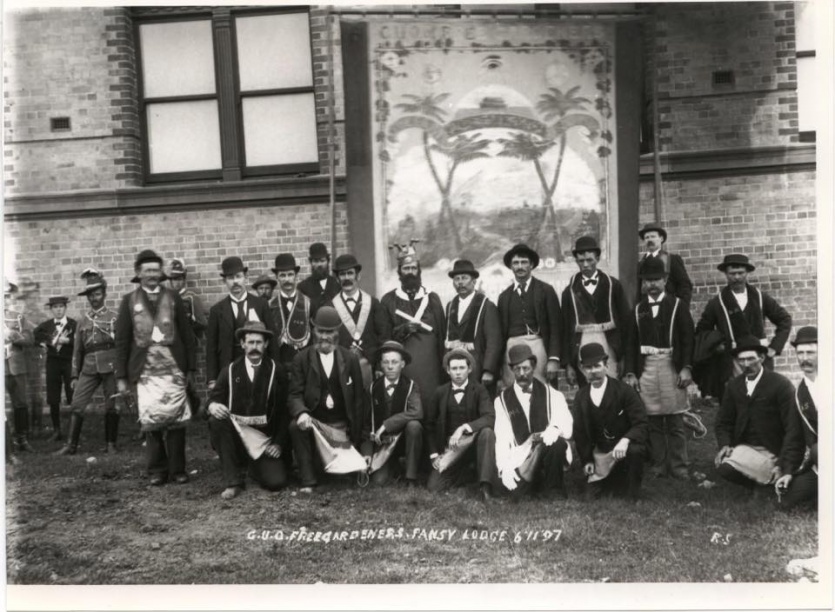
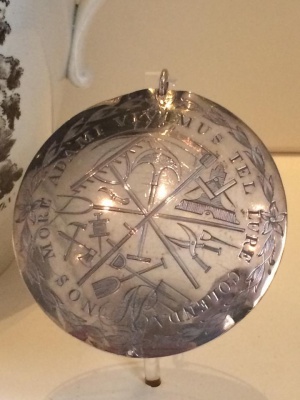
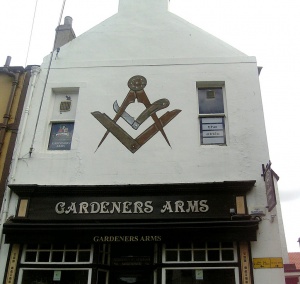

Links
- Ancient Order of Free Gardeners http://freemasonry.bcy.ca/texts/gardeners.html Free Gardeners
- Wikipedia http://en.wikipedia.org/wiki/Order_of_Free_Gardeners
- History of the Free Gardeners "Hanging Gardens of Babymon Lodge" http://hanginggardensofbabylonlodge.webs.com/history

